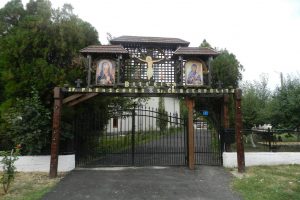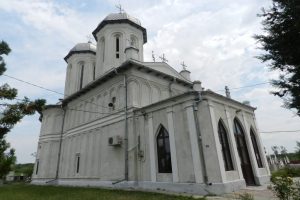

Eugen Ionesco’s statue is located within the Park of the same name in Slatina, since 2007 made by sculptor Ioan Bolborea. The location of the statue is reported in the vicinity of the house where the playwright was born.
Eugen Ionescu (b. November 26, 1909 Slatina – d. March 28, 1994, Paris), known outside Romania as the Eugène Ionesco, was a french language writer, originally from Romania, the protagonist of the Theatre of the Absurd and member of the French Academy . He used to declare that he was born in 1912, or of pure coquetry, or from a desire to create a link between his birth and the death of his great forerunner Ion Luca Caragiale.
His father, Eugene Ionescu, romanian was a lawyer and his mother Marie-Thérèse (née Ipcar) had French citizenship. At the age of four he accompanies his family in France, where it will remain until 1924. The child Ionescu continued his education in Romania, attending the highschool National College St. Sava in Bucharest. He sustained the baccalaureate exam at National College Carol I of Craiova. He enrolls at the Faculty of Letters in Bucharest, obtaining the license for French. Having finished academic courses in 1934 was appointed professor of French in Cernavoda; later he was transferred to Bucharest. In 1936 he marries Rodica Burileanu, and in 1938 he leaves to Paris as a scholarship. There he worked as cultural attache of the Antonescu’s government near the gouverment from Vichy.
The first works of Ionesco are in romanian, with poems published in the magazine “Bilete de papagal” (1928-1931) led by Tudor Arghezi, articles of literary criticism and an attempt of humorous epic “Hugoliada”:
The grotesque and tragic life of Victor Hugo. The debut volume is a volume of poetry and is called “Elegies for tiny beings”.
His first play, La Cantatrice Chauve (“The Bald Soprano”) was represented on 11 May 1950 to the Théatre de la Huchette, under the direction of Nicholas Bataille, being coldly received by the public and by critics. The play shall impose itself gradually after a number of large French culture people write enthusiastic articles about it and it will become the longest piece of this small Parisian theater, Théatre de la Huchette. It follows a very fruitful period in which the author presents, year after year, a new piece. Theater halls remain empty, but gradually a circle of admirers begins to form, which welcomes this comic emerged from the absurd, where the everyday strangeness explodes. The most notable theatre of France, La Comédie Française, presents, in 1966 for the first time, a play by Ionesco, “The thirst and The Hunger”, and then the play King Dies. The year 1970 brings him an important recognition: his election as a member of the French Academy thereby becoming the first writer of romanian origin with such a high distinction. Obsession with death is the great driving force of the work of Eugen Ionescu, from the death of the thought and of the language to the incomprehensible and unacceptable death of the individual. Neither didactic nor moralizing, antisentimental and anticonventional, Ionesco’s theater is a theater game, a real game, thus free and strange, pure and honest, provocative, an exciting chain, vertiginous and in all directions. In fact the comedy and the tragedy intertwine constantly: the lited road of the comedy becomes the road to darkness, to death.



